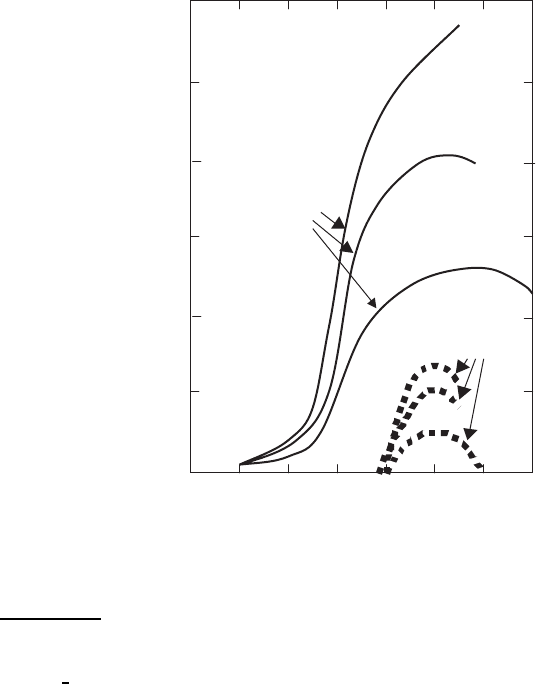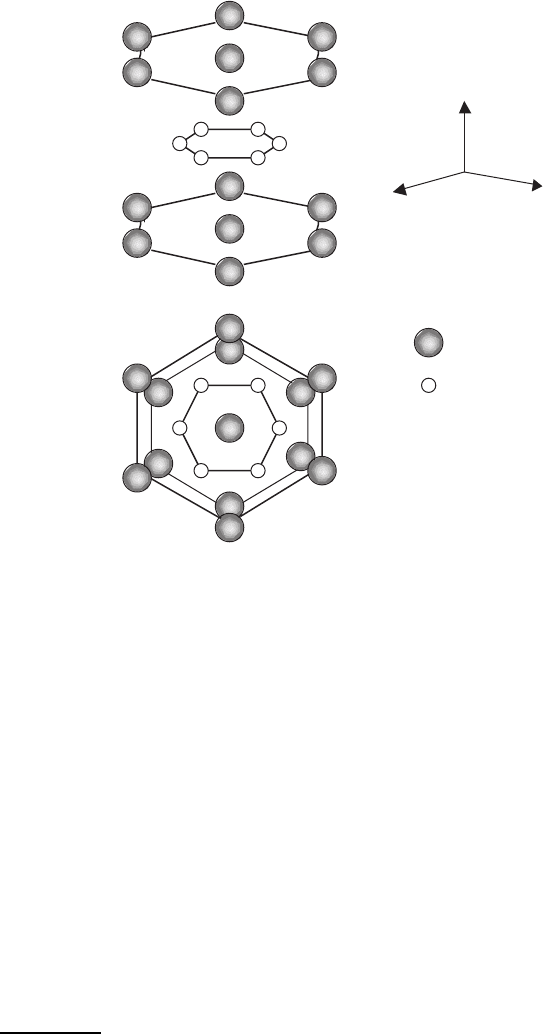Parinov I.A. Microstructure and Properties of High-Temperature Superconductors
Подождите немного. Документ загружается.


A.12 Carbon Superconductors 503
In 2000–2001, J. H. Sch¨on et al. announced that, using an intercalation
with CHCl
3
and CHBr
3
of C
60
single crystals, directed to expansion of the
lattice and formation of high densities of electrons and holes, they reached first
the critical temperature, T
c
= 52 K [943], and then T
c
= 117 K in hole-doped
C
60
/CHBr
3
[944]. Figure A.8 presents the variation in critical temperature as
a function of charge carrier density for electron- and hole-doped C
60
crystals
in different types of intercalation. Obviously, these results rendered doubtful.
1
120
100
80
60
40
20
0
Electron-Doping
Hole-Doping
C
60
/CHCl
3
C
60
/CHBr
3
C
60
Holes/Electrons per C
60
Molecule
Transition Temperature, T
c
(K)
0.5
4.03.53.02.52.01.51.0
Fig. A.8. Variation in T
c
as a function of charge carrier density for electron- and
hole-doped C
60
crystals in incorporation of CHCl
3
and CHBr
3
[944]
1
The critical papers [96,964,965] about J. H. Sch¨on et al. results [940–942,
945–947] have been published in 2002 (see also http://www.lucent.com/
news
events/researchreview/). The papers [940–942, 945–947] have been devoted
to the use of organic molecules, segregated on thin film, as “molecular switches”,
and also to the use of field transistors to change the charge carrier concentration in
different organic matters, providing a regulation to their electric properties (from
dielectric to semiconductor, from metal to superconductor and so on). Suppos-
edly, this rendered to induce high-T
c
superconductivity of the fullerenes C
60
by
electric field. However, first, total identity of the figures (right up to accidental
noise inevitably accompanying any experiment) in [947] and [946] has been found.
The same figure has been also presented in [940], devoted to another type of mi-

504 A Classification of Superconductors
Superconductivity with T
c
= 7 K has been found in C
70
monocrystal with
size of about 1 mm [319]. Obviously, carbon nanotubes (1D molecular con-
ductors) are ideal candidates for research of 1D superconductivity. Today,
maximum critical temperature, T
c
= 15 K, for one-wall nanotubes [1047], and
T
c, on
∼ 11.5 K (beginning of resistive transition), T
c
(R =0)=7.8K, for
multiwall nanotubes [1040] have been reached.
The attempts to switch graphite into superconducting state, using its dop-
ing by different chemical elements, led to superconductivity with T
c
< 1Kfor
cases of K and Na [36, 388]. Introduction of ytterbium and calcium atoms
between graphite layers led to the fabrication of superconducting compounds
with T
c
=6.5 and 11.5 K, respectively [1139]. In this case, the role of Yb and
Ca atoms is that they supply free charge carriers in the graphite layers.
Then, the oriented (111) boron-doped diamond thin films (with boron con-
centration 0.53%) have been grown at (001) silicon substrates, using MPCVD
technique (modification method of the chemical vapor deposition) [1038].
These films demonstrated T
c, on
=7.4K and T
c
(R =0)=4.2K at H =0.
The linear extrapolation gives H
c2
(0) = 10.4T and H
irr
(0) = 5.12 T, the
critical current density J
c
= 200 A/cm
2
at H = 0. First signs of super-
conductivity arose at boron concentration of 0.18%. Finally, the materials,
combining superconductivity, superhardness and high strength (these ma-
terials could be used for research of electric and superconducting proper-
ties under pressure) have been synthesized at high static pressures (up to
7.7 GPa) and temperatures (up to 2173 K) in the following systems [226]: (i)
diamond/Nb, T
c
=12.6K(ΔT =1.5K), H
c2
(4.2K) = 1.25 T (diamond ma-
trix and superconducting channels from niobium carbide); (ii) diamond/Mo,
T
c
=9.3K, ΔT = 5 K (diamond matrix and superconducting channels from
molybdenum carbide); (iii) composites with matrices from superhard mate-
rials (80 wt%) and MgB
2
channels, namely diamond/MgB
2
(T
c
=37K)and
cubic boron nitride/MgB
2
(T
c
=36.1 K), frame of these composites has mi-
crohardness in the range of 57–95 GPa.
A.13 MgB
2
and Related Superconductors
The superconducting system MgB
2
discovered in 2001 demonstrates highest
volume superconductivity (critical temperature, T
c
= 39 K) among non-
copper oxide conductors [756].
2
Crystal structure of MgB
2
,havingspatial
croelectronic devices. In this case, the coincidence has not been in the whole,
but separate parts of the plots coincided totally with one another. Then, eight
cases of the figure coincidence (total or fragmentary) have been found in six pa-
pers of J. H. Sch¨on, devoted to different types of devices for various materials
and temperatures. After that, 100 scientific groups in the world have attempted
unsuccessfully to repeat the results of J. H. Sch¨on et al.
2
WO
3
monocrystals, doped by Na, demonstrate high-temperature superconduc-
tivity with T
c
=91Kinthesurface layer with content of Na
0.05
WO
3
[417].

A.13 MgB
2
and Related Superconductors 505
c
aa
Mg
B
Fig. A.9. Crystal structure of MgB
2
[756]
group of symmetry P 6/mmm, is shown in Fig. A.9 (where a =3.086
˚
A, and
c =3.524
˚
A are the parameters of hexagonal unit cell). It is most surprising
that simplicity and accessibility of this material, known from the beginning of
1950 [496], combines with complexity of the superconductivity phenomenon.
Even in non-textured multiphase MgB
2
samples, superconducting currents
flow in all volume of the sample and are not sensitive to weak magnetic
field (which should suppress J
c
at the existence of Josephson links between
grains). The temperature scaling of the pinning strength practically in all su-
perconducting H–T plane supports the concept that critical current density
is found by the magnetic flux pinning [602]. It has been shown in experiments
that both the transport (i.e., intergranular) j
c
and its dependence on H and
T , totally coincide with those for inductive (i.e., intragranular) j
c
.Thetest
results prove that grain boundaries in MgB
2
are transparent for supercon-
ducting current [194]. It is observed small, but evident anisotropy of critical
field, H
ab
c2
/H
c
c2
=1.1 in the bulks [387]. At the same time, it is found that
H
ab
c2
/H
c
c2
=1.8–2.0inMgB
2
films with c-axis, oriented perpendicular to the
The nature of the observed superconductivity shows that in this case, supercur-
rents flow on the crystal surface but not into its volume.

506 A Classification of Superconductors
film surface [837]. The high-qualitative-oriented MgB
2
films has critical cur-
rent density, j
c
=1.6 × 10
7
A/cm
2
at T =15KandH = 0 [543]. It is stated
that T
c
and residual electric resistivity, ρ
0
, depend only on thickness, d,of
the epitaxial MgB
2
films, but are independent of the film growth rate. An
increase in d leads to increase of T
c
and decreasing of ρ
0
.Now,thevaluesof
T
c
=41.8K and ρ
0
=0.28μΩ · cm at d>300 nm are maximal and minimal
magnitudes, respectively [853]. The record value of H
c2
=52TatT =4.2K
has been reached in one sample of thin MgB
2
films in the field parallel to the
film surface [274].
The irreversibility field, H
irr
,inNb
3
Sn, Nb-Ti and MgB is equal to 20,
10 and 14 T at T =4.2 K, respectively [254]. Generally, the characteristics
of the superconductors MgB
2
,BKBOandA − 15 (see Table A.8) [737] show
similar values. Therefore, this group of superconductors can be considered
as intermediate between the conventional superconductors, subjected to BCS
theory, and the superconductors with high critical temperature.
The attained values of critical current density for MgB
2
-coated conduc-
tors in Fe-sheath [490]: J
c
> 85 kA/cm
2
(T =4.2K and H =0)and
J
c
=23kA/cm
2
(T =20KandH = 0) are nearly sufficient for current-
carrying cables.
3
The required components Mg, B and Fe are lightly acces-
sible chemical elements and method of “oxide powder in tube” used in the
conductor fabrication be very well tested at preparation both low- and high-
temperature large-scale superconductors. Now, this technique can supply high
temperatures of industrial processing. All these factors open a tempting per-
spective of fastest application of MgB
2
systems and MgB
2
-based supercon-
ducting products.
Several compounds, related to MgB
2
, reach the following critical tem-
peratures: BeB
2
(T
c
=0.79 K [1182]); Re
3
B(T
c
=4.7 K [1020]); ZrB
2
(T
c
=5.5 K [309]); ReB
2
(T
c
=6.7 K [1020]); TaB
2
(T
c
=9.5 K [506]);
Nb
0.76
B
2
(T
c
=9.2K atP = 5 GPa [1162]); CaAlSi (T
c
=7.8 K [645]); SrAlSi
(T
c
=5.1 K [645]); MgCNi
3
(T
c
= 8 K [401]); MgAlB
4
(T
c
= 12 K [623]). The
calculations of electronic structure and constant of electron–phonon interac-
tion predict that AgB
2
and AuB
2
should be high-temperature superconduc-
tors with T
c
= 59 and 72K, respectively [590].
Table A.8. Characteristics of Nb
3
Ge (A-15 compound), BKBO (x ≈ 0.4) and
MgB
2
No. Compound T
c
(K) v
F
(10
7
cm/s) ξ(
˚
A) 2Δ/k
B
T
c
B
c2
(T)
1Nb
3
Ge 23 2.2 35–50 4.2 38
2 BKBO 31 3.0 35–50 4.5 32
3MgB
2
39 4.8 35–50 4.5 39
T
c
is the critical temperature; v
F
is Fermi rate; ξ is the coherence length; Δ is the
energy gap; k
B
is Boltzmann constant; and B
c2
is the upper critical magnetic field.
3
MgB
2
-coated conductor (or tape), fabricated by laser evaporation on flexible
metallic tape has J
c
=1.1 × 10
5
A/cm
2
(T =4.2K and H = 10 T) [563].
A.14 Room-Temperature Superconductivity 507
A.14 Room-Temperature Superconductivity
There are at least two papers reporting superconductivity above room temper-
ature. In the first paper, superconductivity is observed in a thin surface layer
of the complex compound Ag
β
Pb
6
CO
9
(0.7 <β<1) at 240–340 K [207]. The
second paper claims that superconductivity exists in carbon-based multiwall
nanotubes at T>400 K [1197].

B
Finite Element Implementation
of Carbon-Induced
Embrittlement Model
Consider the finite element implementation of the governing equations (4.14)
and (4.27) for carbon diffusion and non-mechanical energy flow, respectively
[810]. The next initial and boundary conditions supplement the governing
equations:
C
CT
= C
CT
0
,T= T
0
, at t =0; (B.1)
C
CT
= C
CT
b
, on S
b
; J
C
k
n
k
= ϕ
C
, on S
ϕ
;(B.2)
T = T
s
, on S
T
; −k
∂T
∂x
i
n
i
= ϕ
E
, on S
F
, (B.3)
where C
CT
0
and T
0
are the initial carbon concentration and temperature,
which may vary within material volume V .IfC
CT
0
is larger than carbon
terminal solid solubility, the initial carbon concentration in carbonate equals
the terminal solubility of carbon in carbonate, and the initial carbon volume
fraction is calculated according to (4.15). A similar comment is valid for C
CT
b
,
which is prescribed carbon concentration on S
b
, a part of the bounding surface
S. For the calculation of C
TS
, stress and temperature distributions are taken
into account. ϕ
C
is the prescribed carbon flux on S
ϕ
; ϕ
E
is the prescribed heat
flux on S
F
and T
s
is the prescribed temperature on S
T
.NotethatS
b
∪ S
ϕ
=
S
T
∪S
F
= S. The quantities C
CT
b
, ϕ
C
, T and ϕ
E
may vary with time.
The finite element equations are derived from variational descriptions of
diffusion and energy flow. For this purpose variations of carbon concentra-
tion, δC
C
, and temperature, δT, are considered, which satisfy the boundary
conditions. Therefore,
δC
C
=0 onS
b
(B.4)
δT =0 onS
T
(B.5)
Relation (4.14) is multiplied by a carbon concentration variation satisfying
(B.4). Subsequently, it is integrated over the volume V . Then, taking into

510 B Finite Element Implementation of Carbon-Induced Embrittlement Model
account (4.11), (4.12) and (4.31), the following expression is derived, which is
valid at any time t:
V
δC
C
dC
CT
dt
dV = −
S
ϕ
δC
C
ϕ
C
dS −
V
fD
C
∂C
C
∂x
k
∂(δC
C
)
∂x
k
dV −
−
V
f
−
D
C
V
C
3RT
∂σ
mm
∂x
k
+
D
C
Q
C
RT
2
∂T
∂x
k
C
C
∂(δC
C
)
∂x
k
dV.
(B.6)
The above relation is simplified if, within a time increment, Δt, the change
of carbonate volume fraction is included in C
C
. Value of Δt is order of a
characteristic time, introduced by diffusion and carbonate size, or smaller.
Then
dC
CT
dt
= f
t
dC
C
dt
. (B.7)
Note that C
C
is no longer the carbon concentration in carbonate, but the
carbon concentration in a part of the material, which at time t is in the form
of carbonate and has volume f
t
V .
Spatial discretization is obtained by introducing the usual finite element
interpolation for carbon concentration, carbonate volume fraction, tempera-
ture and stress trace. For example, carbon concentration is calculated from
nodal values as
C
C
= a
q
C
C
q
, (B.8)
where a
q
and C
C
q
are the interpolation function and the nodal carbon con-
centration value for q-node, respectively. Substitution of (B.7) into (B.6) and
use of spatial discretization lead to the finite element equations for carbon
diffusion:
C
pq
dC
C
q
dt
+
D
1
pq
+ D
2
pq
C
C
q
= F
p
, (B.9)
where
C
pq
=
V
f
t
a
p
a
q
dV, D
1
pq
=
V
f
t
D
C
∂a
p
∂x
k
∂a
q
∂x
k
dV ; (B.10)
D
2
pq
=
V
f
t
−
D
C
V
C
3RT
∂a
r
∂x
k
σ
r
mm
+
D
C
Q
C
RT
2
∂a
s
∂x
k
T
s
a
q
∂a
p
∂x
k
dV ;
F
p
= −
S
ϕ
a
p
ϕ
C
dS. (B.11)
The time derivative of carbon concentration is approximated by
dC
C,t+Δt
q
dt
=
1
Δt
C
C,t+Δt
q
− C
C,t
q
. (B.12)

B Finite Element Implementation of Carbon-Induced Embrittlement Model 511
Relation (B.9) is taken at time t +Δt. Equation(B.12) is substituted into
(B.9) and the D
2
pq
-term is transferred to the right hand, leading to the next
relation (similar to the one developed in [1003] for hydrogen diffusion due to
concentration and stress gradient):
1
Δt
C
pq
+ D
1
pq
C
C,t+Δt
q
= F
p
− D
2
pq
C
C,t
q
+
1
Δt
C
pq
C
C,t
q
. (B.13)
The matrices C
pq
, D
1
pq
and D
2
pq
are calculated by using the known nodal
values of carbonate volume fraction, temperature and stress from the previous
calculation step. The value of carbonate volume fraction corresponds to time
t. However, the values of temperature and stress correspond to time t +Δt,
according to the discussion at the end of Appendix B. Vector F
p
is calculated
from the boundary conditions at time t +Δt. Note that the solution of (B.13)
provides a preliminary carbon concentration value, C
C,pr
t+Δt
, which according to
(B.7) may include carbon in carbonate. This preliminary value can be used
for the determination of the total carbon concentration
C
CT
t+Δt
= f
t
C
C,pr
t+Δt
, (B.14)
as well as the new carbonate volume fraction, f
t+Δt
:
f
pr
=
C
CT
t+Δt
− C
TS
t+Δt
C
C
− C
TS
t+Δt
; f
t+Δt
=
0,f
pr
< 0;
f
pr
, 0 ≤ f
pr
≤ 1 ,
(B.15)
where C
TS
t+Δt
is calculated based on the results for temperature and stress
from the previous calculation step.
The new carbon concentration in the carbonate is derived, based on (B.15),
as
C
C
t+Δt
=
C
C,pr
t+Δt
,f
pr
< 0,
C
TS
t+Δt
, 0 ≤ f
pr
≤ 1 .
(B.16)
Then, the finite element implementation of the governing equations for
non-mechanical energy flow will be obtained. Relation (4.27) is multiplied by
a temperature variation, satisfying (B.5). Subsequently, it is integrated over
volume V and the following expression is derived, which is valid at any time t:
V
δTρc
p
dT
dt
dV +
V
δT
Δ
H
car
V
car
df
dt
dV
= −
S
F
δTϕ
E
dS −
V
k
∂T
∂x
i
∂(δT)
∂x
i
dV −
V
δTJ
CT
n
∂μ
C
∂x
n
dV. (B.17)
As in the case of the carbon diffusion, spatial discretization is introduced
and the following finite element equations are derived:
H
qr
dT
r
dt
+ K
qr
T
r
=Φ
1
q
+Φ
2
q
− L
qs
df
s
dt
, (B.18)

512 B Finite Element Implementation of Carbon-Induced Embrittlement Model
where
H
qr
=
V
ρc
p
a
q
a
r
dV ; K
qr
=
V
k
∂a
q
∂x
i
∂a
r
∂x
i
dV ; (B.19)
Φ
1
q
= −
S
F
a
q
ϕ
E
dS;Φ
2
q
= −
V
a
q
J
C
n
∂μ
C
∂x
n
dV ; L
qs
=
V
ΔH
car
V
car
a
q
a
s
dV.
(B.20)
Assuming that temperature time derivative is given by
dT
t+Δt
r
dt
=
1
Δt
T
t+Δt
r
− T
t
r
, (B.21)
and following an approach similar to that for carbon diffusion, one may derive
the next algebraic system from (B.18)
H
qr
Δt
+ K
qr
T
t+Δt
r
=Φ
1
q
+Φ
2
q
− L
qs
df
t
s
dt
+
H
qr
Δt
T
t
r
, (B.22)
where Φ
1
q
is calculated from the boundary conditions at time t+Δt.Inorderto
estimate Φ
2
q
, the nodal values of temperature, carbon concentration, carbonate
volume fraction and stress from the previous calculation step are used.
A complete calculation cycle is as follows. At time t, all field quantities are
known: u
t
i
,ε
t
ij
,σ
t
ij
,C
C
t
,f
t
,T
t
, dC
C
t
/dt, df
t
/dt, dT
t
/dt,whereu
i
are the compo-
nents of the displacement vector of a material particle. A time increment Δt
is considered and the following calculation steps are performed:
(1) Material deformation problem is solved first. The boundary conditions of
the applied traction and/or displacements are defined at time t+Δt.The
isotropic expansion strain rate due to carbon dissolution, carbonate for-
mation and thermal expansion is calculated by using the values and time
rates of carbon concentration, carbonate volume fraction and tempera-
ture at time t. The parameters of the de-cohesion model are also derived
from carbonate volume fraction and temperature distribution at time t.
By performing calculation step (1), u
t+Δt
i
,ε
t+Δt
ij
and σ
t+Δt
ij
are calculated.
(2) The energy flow problem is solved next. The boundary conditions of the
applied surface temperature and/or heat flux are defined at time t +Δt.
Φ
2
q
-term is calculated, based on the distributions of temperature, carbon
concentration and carbonate volume fraction, at time t,aswellasonthe
distribution of stress, σ
t+Δt
ij
, calculated within step (1). The carbonate
volume fraction rate, at time t, is used for the calculation of L
qs
-term. By
performing calculation step (2), T
t+Δt
is calculated.
(3) The carbon diffusion problem is solved at the end. The boundary con-
ditions of the applied surface carbon concentration and/or carbon flux
are defined at time t +Δt.Inallterms,f
t
is used. D
2
pq
-term is calcu-
lated, based on the values σ
t+Δt
ij
and T
t+Δt
, derived using steps (1) and
B Finite Element Implementation of Carbon-Induced Embrittlement Model 513
(2), respectively. By performing calculation step (3), C
C
t+Δt
and f
t+Δt
are
calculated.
The material deformation problem is solved, assuming a constant value
of Young’s modulus. The error in the calculations is further minimized, con-
sidering the value of E for the temperature in the crack-tip region, where
embrittlement and fracture processes operate. When the variation of temper-
ature, either in space or in time, is significant, its effect on elastic modules
should be taken into account (see, e.g., [865]).
Adequate numerical results by using the finite element implementation
can be obtained after carrying out preliminary tests, estimating properties of
carbon, cuprate, carbonate and YBCO superconductor, which are necessary
for calculation.
